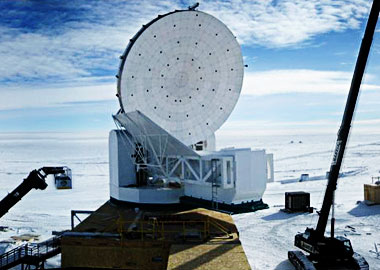
 Ghosts of the Future:
Ghosts of the Future:
First Giant Structures of the Universe
Astronomers using the South Pole Telescope report that they have discovered the most massive galaxy cluster yet seen, at a distance of 7 billion light-years. The cluster (designated SPT-CL J0546-5345) weighs in at around 800 trillion Suns, and holds hundreds of galaxies.
“This galaxy cluster wins the heavyweight title. It’s among the most massive clusters ever found at this distance,” said Mark Brodwin, a Smithsonian astronomer at the Harvard-Smithsonian Center for Astrophysics. Brodwin is first author on the paper announcing the discovery, which appeared in the Astrophysical Journal.
Located in the southern constellation Pictor (the Painter), the cluster has a redshift of z=1.07. (Redshift measures how light from a distant object has been stretched by the universe’s expansion.) This puts it at a distance of about 7 billion light-years—meaning that we see it as it appeared 7 billion years ago, when the universe was half as old as now and our solar system didn’t exist yet.
Even at that young age, the cluster was almost as massive as the nearby Coma cluster. Since then, it should have grown about four times larger. If we could see it as it appears today, it would be one of the most massive galaxy clusters in the universe.
“This cluster is full of ‘old’ galaxies, meaning that it had to come together very early in the universe’s history—within the first two billion years,” stated Brodwin.
Galaxy clusters like this can be used to study how dark matter and dark energy influenced the growth of cosmic structures. Long ago, the universe was smaller and more compact, so gravity had a greater influence. As the universe expanded at an accelerating rate due to dark energy, it grew more diffuse. Dark energy now dominates over the pull of gravity and chokes off the formation of new galaxy clusters.
Brodwin and his colleagues spotted their quarry in the first 200 square degrees of data collected from the new South Pole Telescope. The SPT is currently completing its pioneering millimeter-wave survey of a huge swath of sky covering 2,500 square degrees.
In their search for giant galaxy clusters, the team uses the Sunyaev-Zel’dovich effect—a small distortion of the cosmic microwave background (a pervasive all-sky glow left over from the Big Bang). Such distortions are created as background radiation passes through a large galaxy cluster.
Surveying for this effect has significant advantages over other search techniques. It works just as well for very distant clusters as for nearby clusters, which allows astronomers to find very rare, distant, massive clusters. Further, it provides accurate measurements of the masses of these clusters, which are crucial to unraveling the nature of dark energy.
Once this distant cluster was found, the team studied it with the Infrared Array Camera on the Spitzer Space Telescope to pinpoint galaxies within the cluster. Detailed observations of the galaxies’ speeds with the Magellan telescopes in Chile proved that the galaxy cluster was a heavyweight.
The South Pole Telescope is an NSF funded project, run by an international collaboration involving scientists at over a dozen institutions. See http://pole.uchicago.edu for more information.
For images:
http://www.cfa.harvard.edu/news/2010/pr201020_images.html
CLOSER TO HOME…
Meanwhile, much closer to home, the Community Star Party in Westchester, originally set for Sept. 18 but clouded out, has been rescheduled for this Saturday, Oct. 16, 7:00 p.m. Our telescopes will be set up in the Christian Science Church parking lot at 7855 Alverstone Ave. (corner of Alverstone and 79th St., just a short block west of Sepulveda Blvd.). Children are especially welcome. If the sky is cloudy, come anyway — in that case we’ll have a learning session on basic astronomy in the church, especially geared for the children.
Planet Jupiter and the first-quarter Moon are both well situated that evening for viewing. Jupiter, the “giant planet,” is the closest and brightest it’s been since 1963, and it won’t be this bright again until 2022. To commemorate this and to “Welcome the Giant,” the international organizations Astronomers Without Borders and Sidewalk Astronomers are holding star parties worldwide. Our star party is part of this worldwide celebration. For more information, see:
http://www.astronomerswithoutborders.org/projects/beauty-without-borders/480.html
Questions? Call or email star party coordinator Bob Eklund, (310) 216-5947, email [email protected], website www.bobeklund.com





Be the first to comment